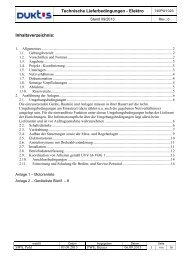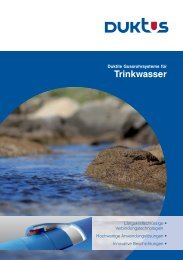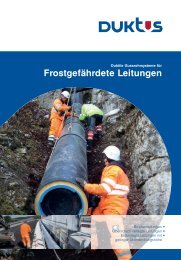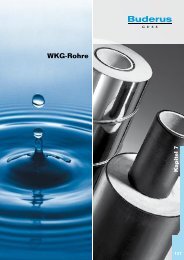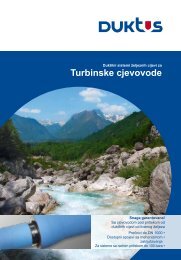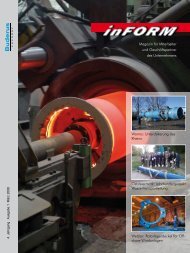Buderus Manual on Trenchless Installation of Ductile Cast ... - Duktus
Buderus Manual on Trenchless Installation of Ductile Cast ... - Duktus
Buderus Manual on Trenchless Installation of Ductile Cast ... - Duktus
You also want an ePaper? Increase the reach of your titles
YUMPU automatically turns print PDFs into web optimized ePapers that Google loves.
<strong>Trenchless</strong> replacement <strong>of</strong> gas and water pipelines<br />
The greatest impetus to innovate in the field <strong>of</strong> trenchless replacement came from Berlin,<br />
where Germany‘s oldest systems <strong>of</strong> grey cast ir<strong>on</strong> water pipes had by then been in<br />
use for more than 120 years and urgently needed to be renovated. There were external<br />
c<strong>on</strong>diti<strong>on</strong>s in Berlin that made replacement more difficult and these took the form <strong>of</strong> the<br />
following requirements:<br />
1. The pipes are situated in the area where the roots <strong>of</strong> the trees at the edges <strong>of</strong> the<br />
pavements lie. The trees are strictly protected and under no circumstances may the<br />
roots be harmed. It is not possible for trenches to be dug for c<strong>on</strong>venti<strong>on</strong>al laying.<br />
2. Replacement techniques where the old pipes remain in place al<strong>on</strong>g the run, either<br />
unbroken or in fragments, cannot be used. Any pipes or fittings which are not in use<br />
have to be removed in their entirety.<br />
This meant that the development <strong>of</strong> two special pipe replacement techniques, namely<br />
the press-pull technique and the auxiliary pipe technique, was almost pre-ordained;<br />
specificati<strong>on</strong>s serving as a foundati<strong>on</strong> for both these techniques now exist as technical<br />
rules laid down by the DVGW in the form <strong>of</strong> Arbeitsblatt GW 322-1 [3.1] and Arbeitsblatt<br />
GW 322-2 [3.2]. Both techniques can be used for the trenchless replacement <strong>of</strong><br />
pipelines, following the same route, with new pipelines <strong>of</strong> the same or larger nominal<br />
sizes (e.g. new DN 12 /1 0 pipes to replace old DN 100 <strong>on</strong>es, see Table 3.1), with the<br />
pipes making up the old pipeline being recovered either as fragments or as complete<br />
lengths. This gives the following advantages:<br />
1. Valuable raw materials are recycled.<br />
2. There is <strong>on</strong>ly minimal disrupti<strong>on</strong> <strong>of</strong> ground surfaces and nature.<br />
3. No new runs <strong>of</strong> pipe are installed in the space available below ground level.<br />
Table 3.1: Maximum increases in nominal sizes with trenchless replacement to<br />
GW 322-1 or GW 322-2<br />
3<br />
Nominal size <strong>of</strong> old pipes Maximum nominal size <strong>of</strong> new pipes<br />
DN 80 DN 1 0<br />
DN 100 DN 200<br />
DN 1 0 DN 200<br />
DN 200 DN 300<br />
DN 300 DN 00<br />
DN 00 DN 00



